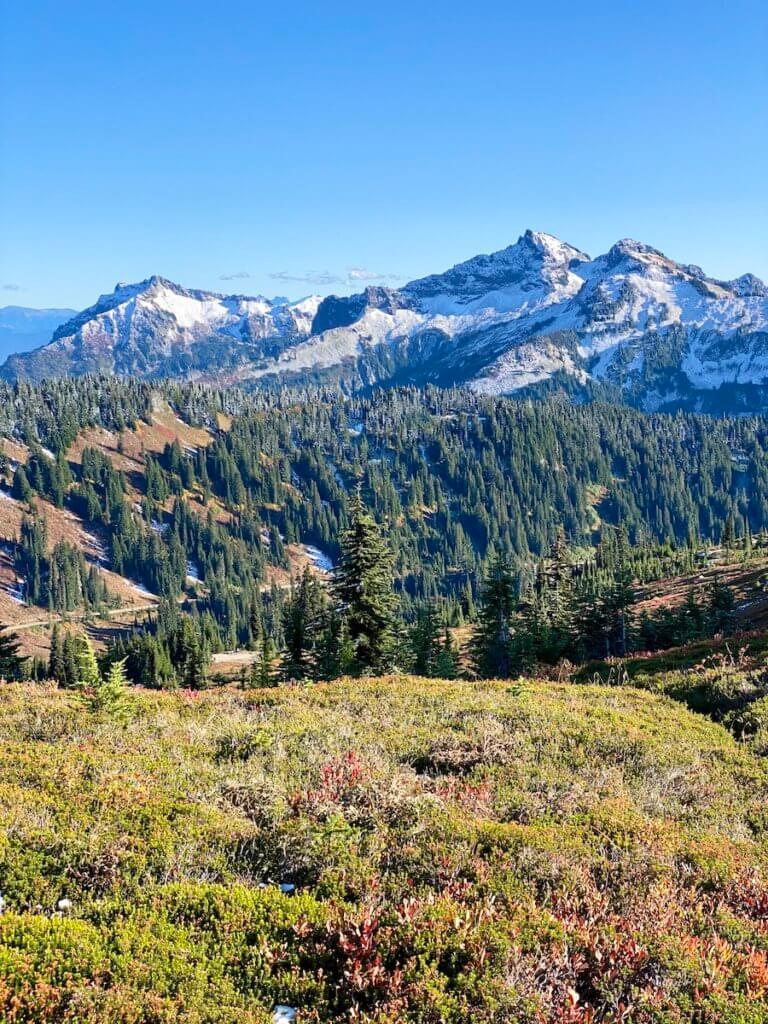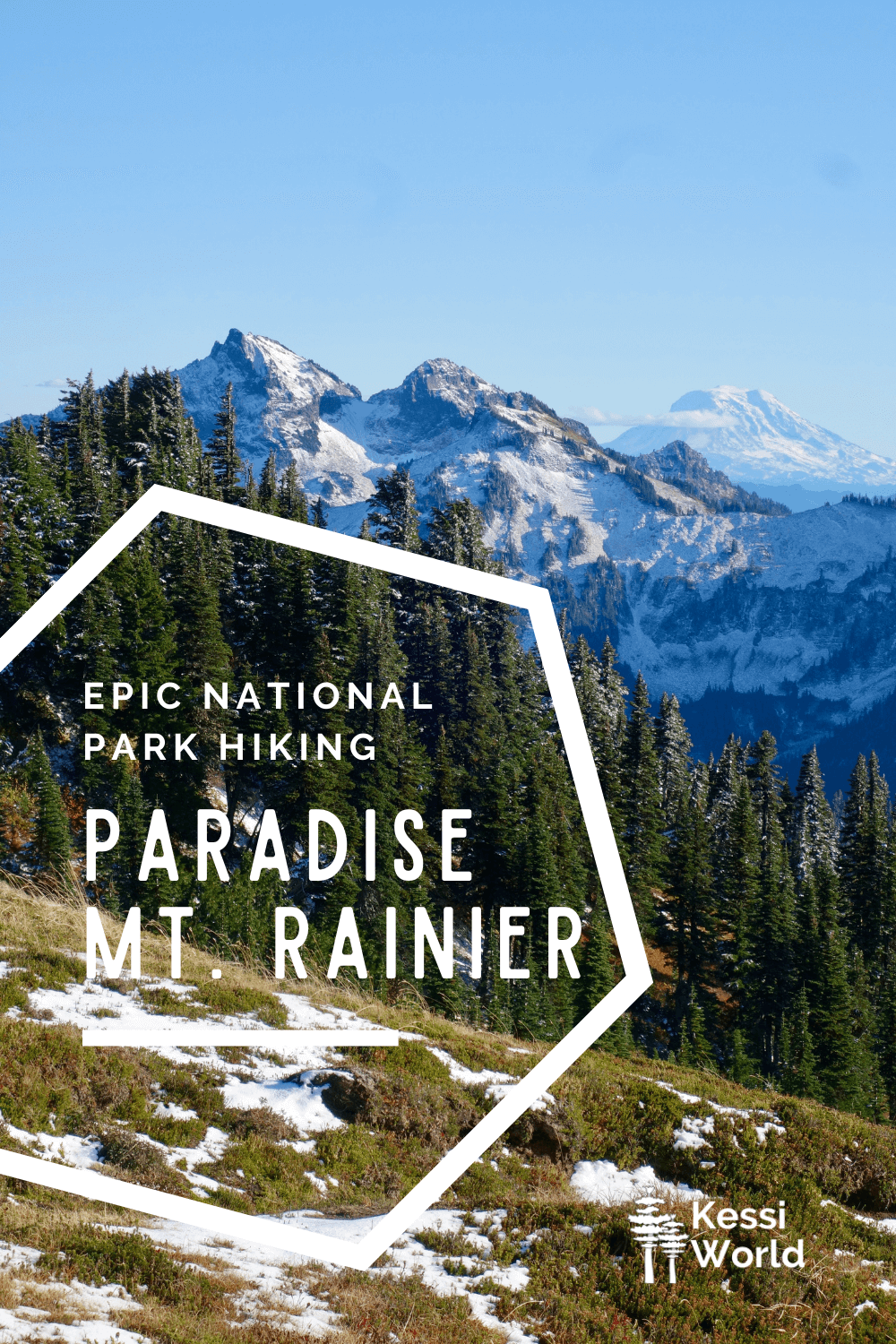Exploring Paradise at Mt. Rainier — National Park escape.
Explore pristine Paradise at Mt. Rainier with me. Includes tons of fall color photos and helpful planning information for Mount Rainier National Park.
Paradise Mt. Rainier is the premier offering of beautiful Mt. Rainier National Park. The 14,411 feet peak towers above the Seattle-Tacoma metropolis in Washington State for all the world to see. At least, when she wants you to see her!
Locals usually say something like, “When the mountain is out” to indicate clear viewing of what the Coast Salish call Tahoma or other names like Takhobah, Taxuma, Takobud, and more.
Besides viewing the mountain from countless flights to/from Seatac Airport, I’ve enjoyed experiencing so many aspects of this pristine piece of nature — protected in 1899 with the creation of Mt. Rainier National Park.
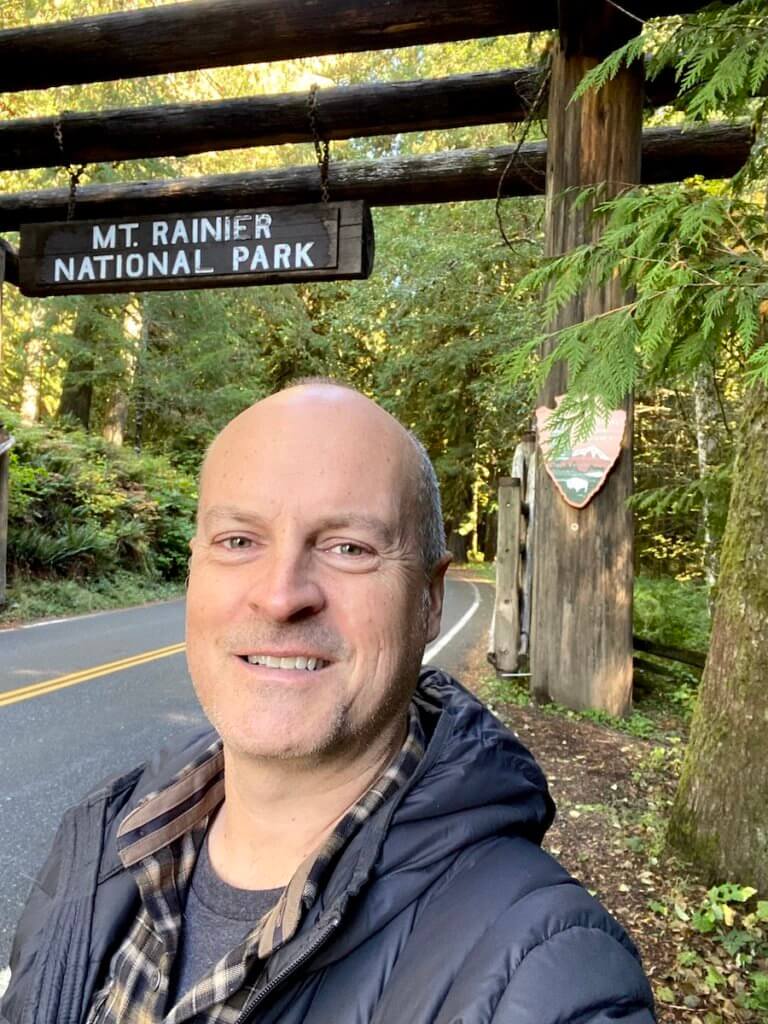
As a child our family piled in the car and meandered our way to the sweeping views of Paradise at Mt. Rainier. We’d play in the snow, or wander through the wildflowers, and later visited the Visitor Center to learn about the science behind it all.
Later, I’d climb to the summit in a middle-of-the-night shuffle that remains one of my proudest accomplishments. That expedition also left from Paradise on Mt. Rainier. I remember the night following the descent we stayed at the iconic Paradise Inn. After a short dinner I fell asleep sitting upright on my bed attempting to remove my socks!
Each season at Paradise on Mt. Rainier offers a unique beauty — even on the days when mysterious clouds form a choreography around her summit.
Follow along for a colorful fall hike at Paradise Mt. Rainier
Paradise at Mt. Rainier — Table of Contents
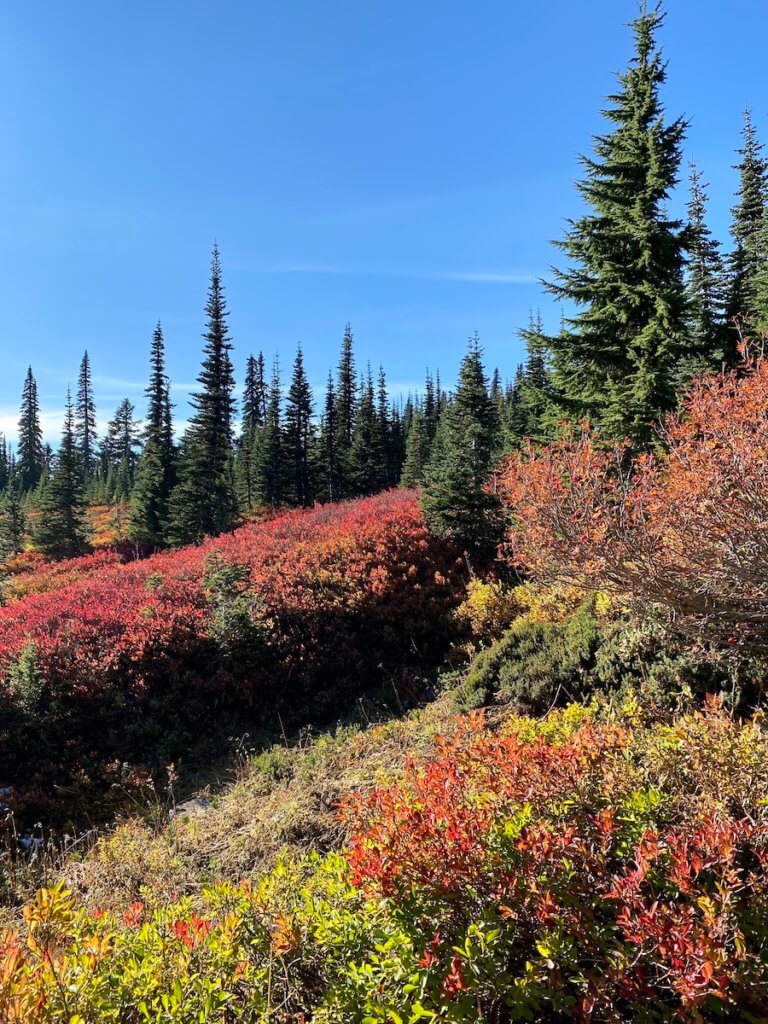
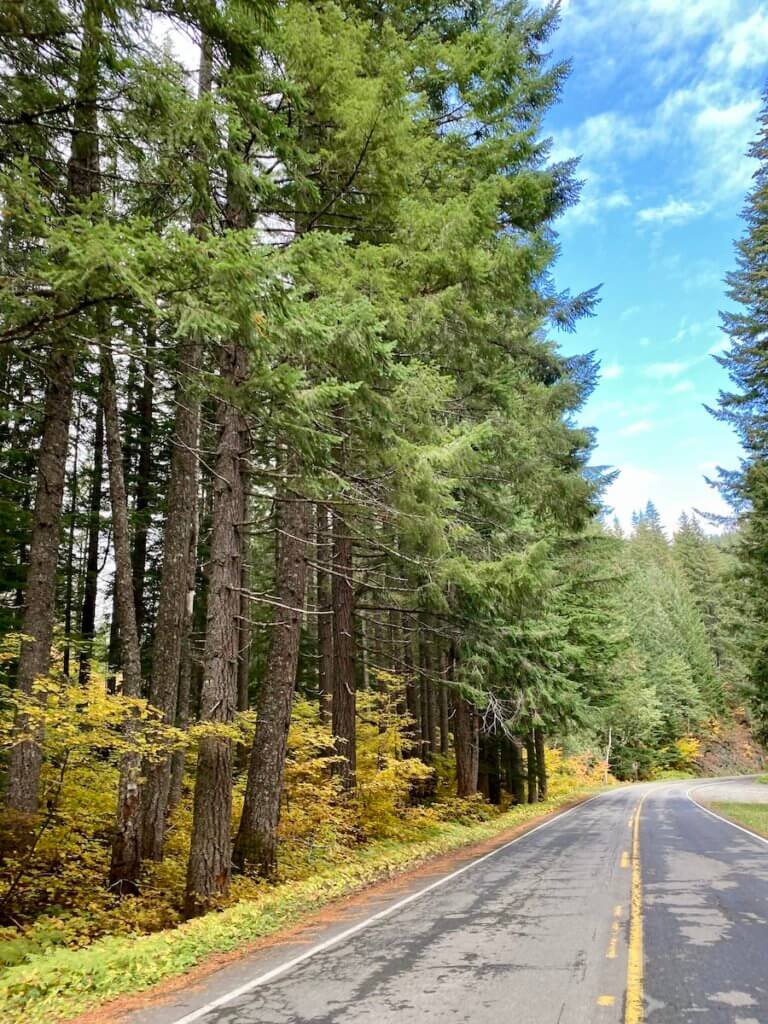
Getting to Paradise Mt. Rainier
While I’d usually leave super early to beat the rush of crowds — because Paradise Mt. Rainier is very popular — I try a different approach today. Knowing that I’ll be staying overnight in the National Park, I wait to leave until noon and then set out in normal Seattle area traffic. I don’t usually recommend this approach in Summer or on weekends. Otherwise, it’s a long day trip or makes for a pleasant overnight inside or near the Park.
The drive is typical and takes about two hours (from Seattle) to reach the Ashford area, where I stop for a quick bite at Rainier Basecamp Bar & Grill (closed in Winter). This is the last stop for gas and aside from limited offerings at National Park Inn, not many food options are available in the Park in the off season (October – May).
There are four main approaches to the Park, but the Nisqually Entrance, on Hwy 706, is the most direct to Paradise. I have a more informational article about all the details to plan a trip from Seattle to Mt. Rainier.
The road to Paradise is lined with waterfalls and great views
Even if you’re not planning to hike, the road to Paradise at Mt. Rainier is amazing. It is open year-round, but once the snow seriously begins to fall traction devices are required, similar to other mountain passes in the Cascades in winter. It makes sense, because the twists and turns in the road take attention — even when the inclination is to stare out at the abundant beauty along the path. Don’t worry, there are many places to safely pull off the road to view the dramatic scenery — it is easier to stop on the way up the mountain.
Although I make a beeline to the top, and visit them the following day, I recommend stopping at Christine and Narada Falls along the way. They are uniquely different and easy to access from parking on the main road. Christine Falls is perfectly framed by a WPA-built arched bridge. The parking area isn’t huge and can take you by surprise at the tight turn in the road, so be ready.
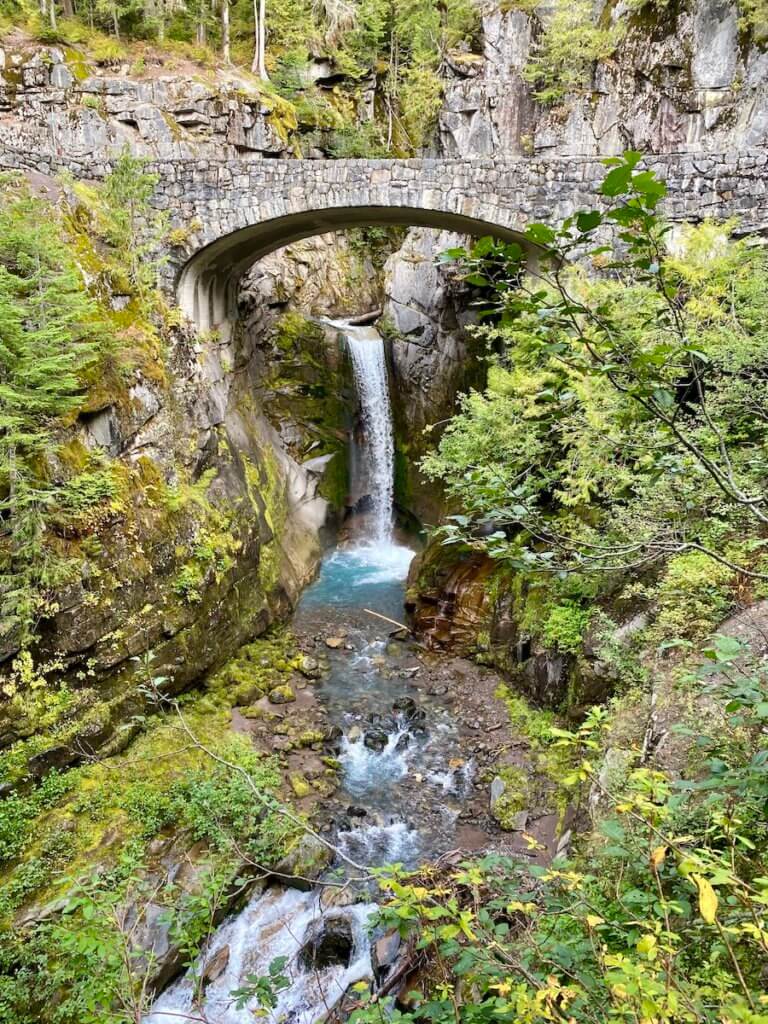
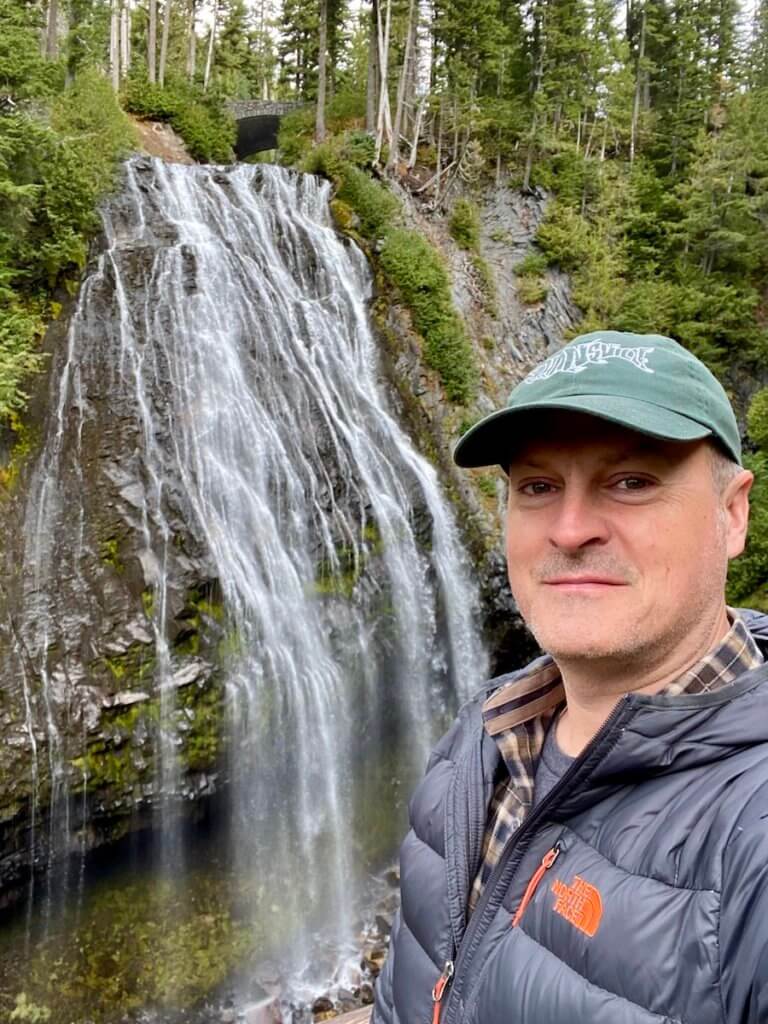
The road to Paradise is lined with waterfalls and great views
Narada Falls provides an excellent example of the basalt rock formations created with ages of lava flows from Mt. Rainier, the volcano that remains “active” to this day. The parking area is substantial, making it a convenient stop.
On the other side of the Paradise River (opposite of the Falls), the Tatoosh Range serves up “old-school” peaks created by tectonic plates shifting rather than volcanic activity. This is also the closest trailhead to Paradise for longer hikes along the 93-mile Wonderland Trail, which makes a complete loop around Mt. Rainier.
Arriving at Paradise Mt. Rainier
The main parking area adjacent to Paradise Inn and the Henry M Jackson Memorial Visitor Center fills up quickly in the Summer months and on weekends, but by the time I arrive at around 3PM there are open spots right near the trailhead. This is a Thursday in October, but normally I’d probably need to use the lower parking lot, which is about half a mile away — and easily connected by trails. Guests of the Paradise Inn have access to spots in the turnaround area of the statuesque lodge.
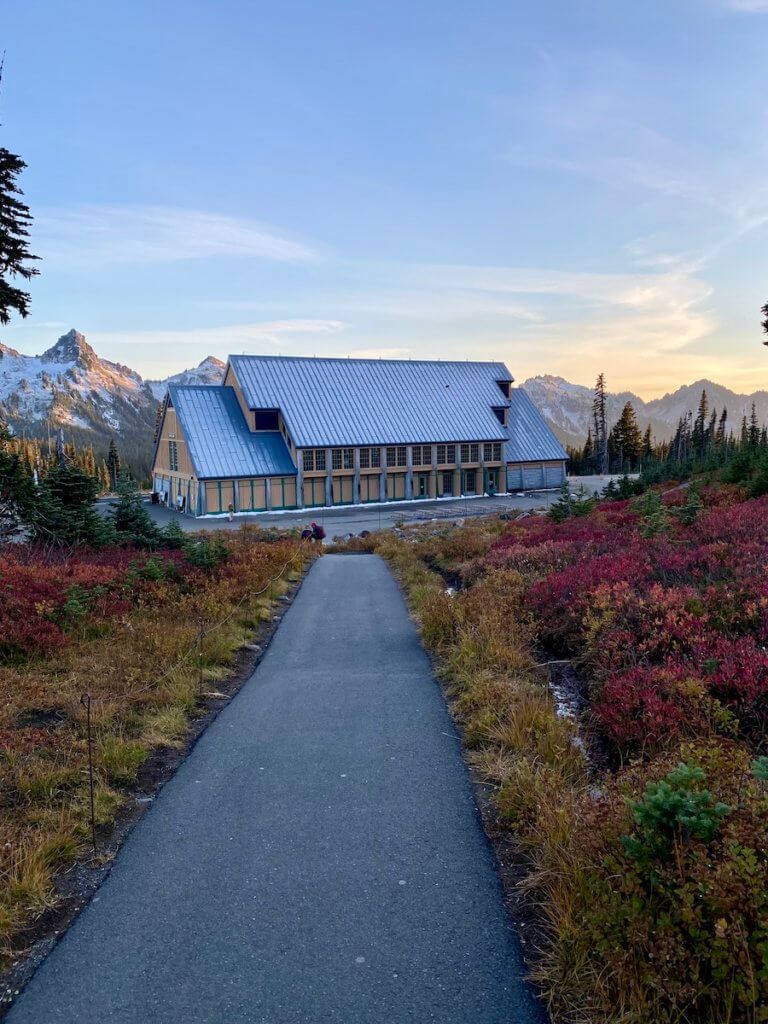

How to prepare for alpine hiking
It’s always recommended to carry the 10 essentials when hiking — especially if you plan to venture on longer treks to places like Camp Muir. There are paper maps in containers around the Visitor Center, and I always take a picture of the large map display with my phone to reference along the way. Also, cell service is relatively good around the parking area but gets spotty quickly as you ascend the trails.
- Map of the area
- Compass
- Extra food and water
- First aid kit
- Flashlight or headlamp
- Sunglasses and sunscreen
- Pocketknife
- Extra clothing and rain gear
- Emergency shelter
- Matches in a waterproof container
Do you want to practice a nature connection with Mt. Rainier today?
The most magical and memorable experiences on Mt. Rainier come from taking time to slow down and find grounding. This allows you to open up to a newfound sense of belonging, even if you’ve never visited Washington State before.
If you need clarification on what this means or are well-versed in nature connection but still curious, consider joining me for one of my YouTube videos. They are all about finding your way to tap into Nature’s Intelligence, regardless of your experience level or location. You’ll have access to my lifelong mystic gift of leading people into their own wild nature — in ways that might surprise you.
And the more you practice, the more you’ll be ready for transformational experiences on Mt. Rainier. It starts with allocating 20 minutes of your day to mindful time in the Natural World.
Why 20 minutes???
A growing body of research points to the beneficial effects of exposure to the natural world on health, reducing stress, and promoting healing. Some studies further clarify that only 20 minutes daily (of immersive natural experience) is essential to producing lasting benefits such as lower blood pressure, higher concentration, improved mental health, and neutralizing inflammation.
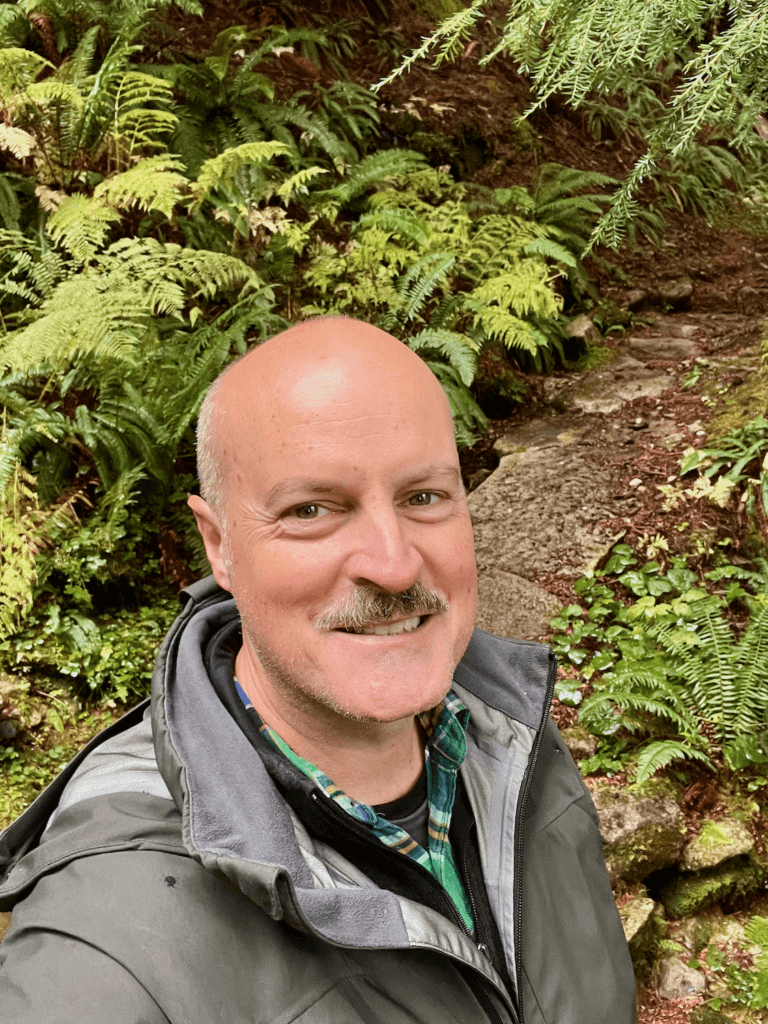
Join me on a YouTube video on Mt. Rainier — a 20 Minute Guided Nature Connection.
How can Nature’s Intelligence help us shine through daily life’s nervous energy ups and downs? This is a path to get out of your head and into your own nature! Quiet your mind, open your heart, and allow your intuition to flow by following this guided Nature Connection Experience through a waterfall hike in the secret corner of Mt. Rainier National Park.
For simpler Nature Meditation, also in the rainforest of Mt. Rainier, visit this YouTube video.


Paradise at Mt. Rainier — hiking trails
Since there aren’t too many people around, I decide to take the well-marked Skyline Trail, which is popular for fantastic views from all angles above the treeline. Mt. Rainier takes command in one direction while her friends — Mt. Adams and Mt. St. Helens — rise up in the distance to the South. The entire trail is over 6 miles, but because it’s later in the afternoon I customize an up and back version that is about 4.5 miles and takes two hours to complete. The whole trail requires about 3-4 hours for a person in average shape. Clockwise is the recommended direction.
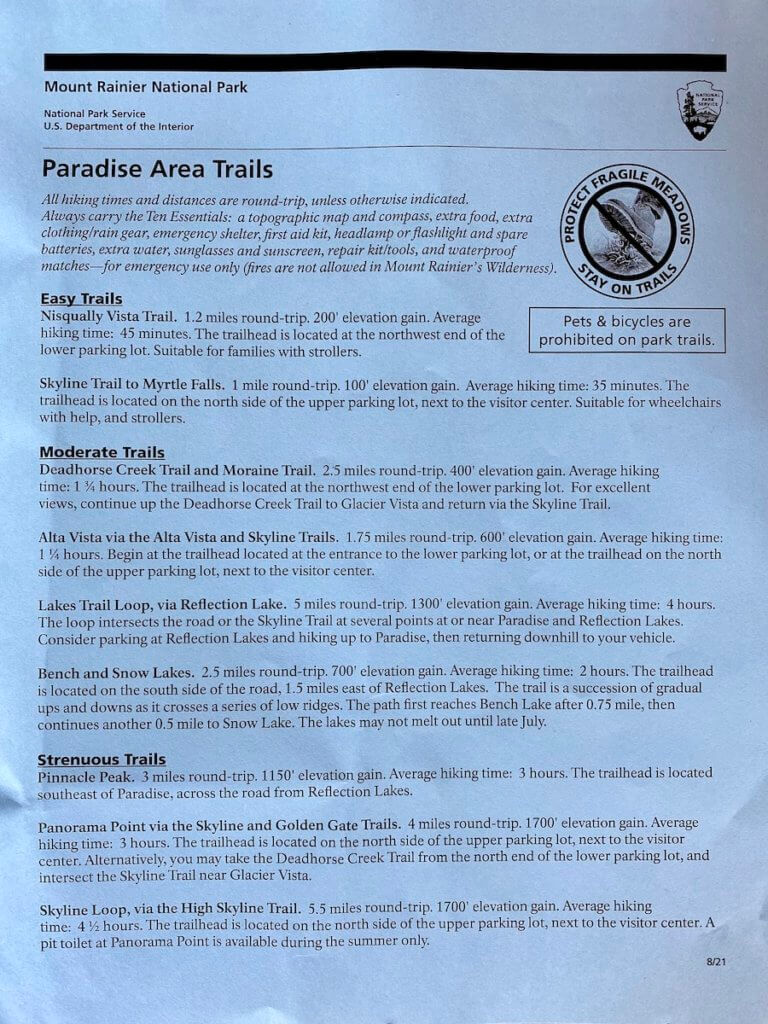
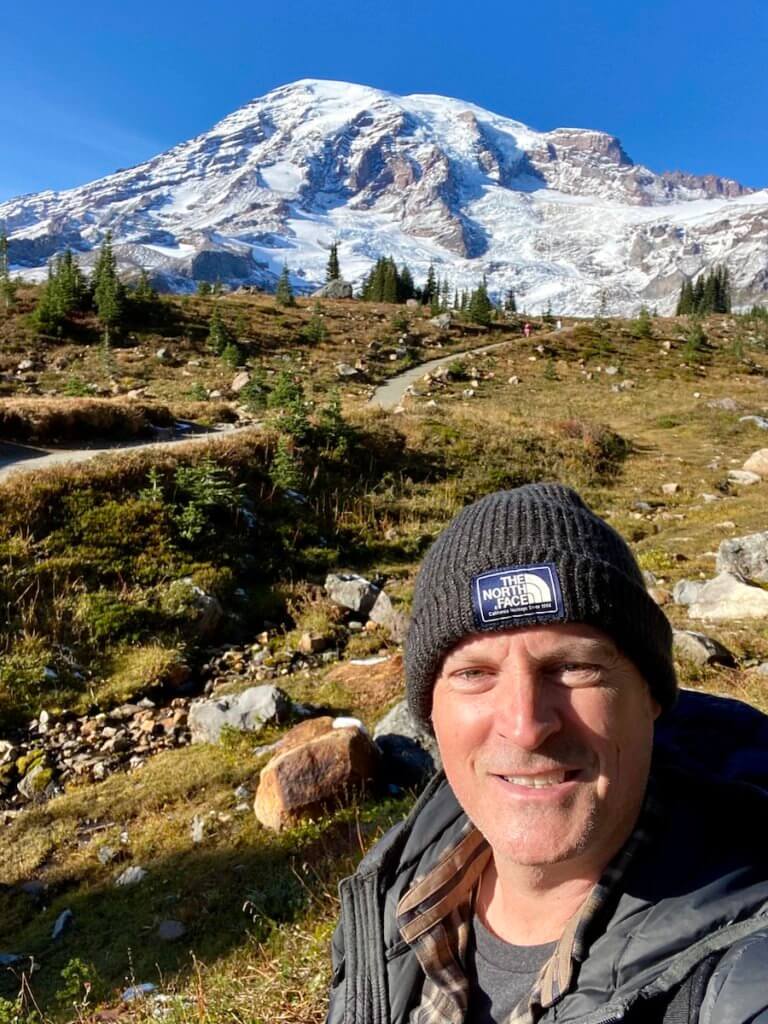
Trail etiquette on Mt. Rainier
It’s very important to do my part to protect the meadows, which are very fragile and prone to damage by so many visitors. I stay on the marked trails and of course don’t try to take anything along the way. Here are a few guidelines for respecting the beauty available at Paradise:
- Stay on trails.
- Do not pick the flowers, or take anything.
- Leave no trace of your visit.
- Pets are not allowed on any trails around Paradise.
- Do not feed or approach wildlife.
I feel it’s important to also be mindful of others on the trail and make space for those coming up by pulling off to the side. Common courtesy also means saying hello to others and acknowledging their presence — be friendly.
The Skyline Trail
Since I’m parked right near the trailhead, it’s easy to hop from my vehicle and get started. The trail is paved and heads uphill quickly. While the wildflowers are mostly gone, October has kissed the low brush with an autumn color palette that lights up with red, orange and yellow. The collage pops against the green fir and blue sky and soon enough views of majestic Mt. Rainier comes into view.
The trail roughly follows the outline of what’s left of the Nisqually Glacier. This time of year, there is already a fresh dusting of snow that adds texture to the climb. The parking area is at 5,400 feet in elevation and the climb to Panorama Point rises another 1,380 feet to 6,800 feet. While this isn’t a high altitude compared to other parts of the Cascades, I can feel the difference from my sea level home. My mountain climbing experience tells me to take it slow and drink lots of water along the way.

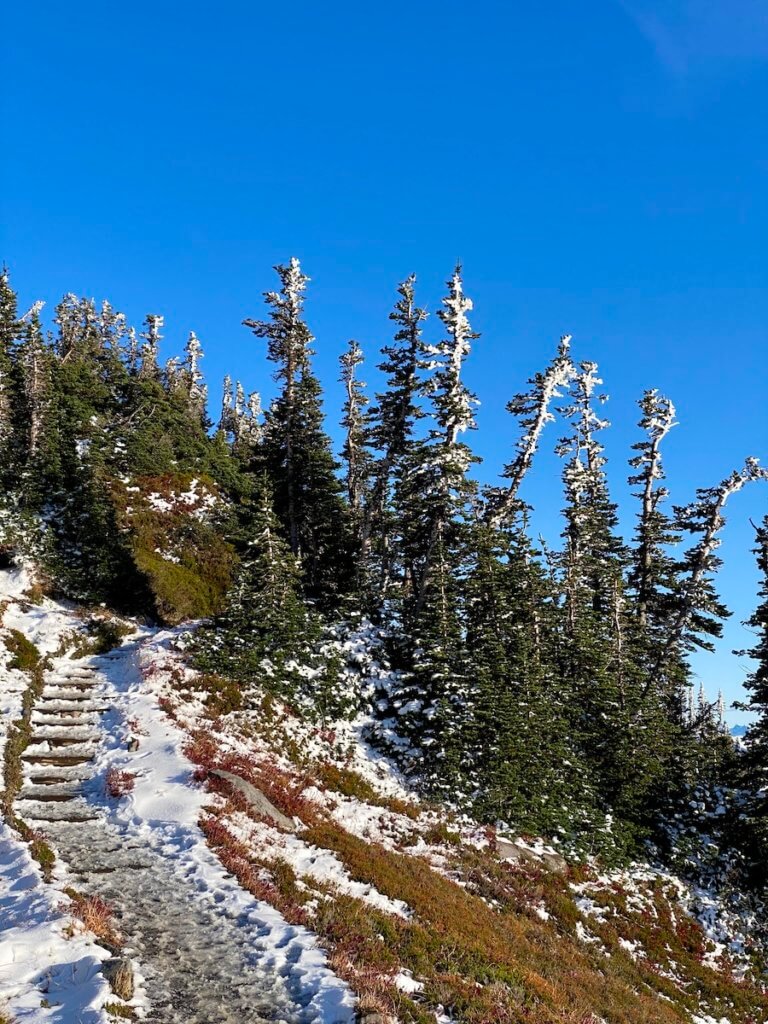
The final 3/4 of a mile between Glacier Vista and Panorama Point offers a fun traverse over a rocky trail that hugs the side of the mountain. Views are amazing, looking toward Mt. Adams and Mt. St. Helens as the sun begins to lower over the horizon. The melted snow on the trail creates a slushy walk and the rocks can be a bit slippery.
Panorama Point is a great pivot mark for me to return to my vehicle, since the sun is getting ready to set and I don’t want to hike in darkness. The view over the Cascades is soul-nourishing and I’m glad I got my ass out of bed to make this hike today!
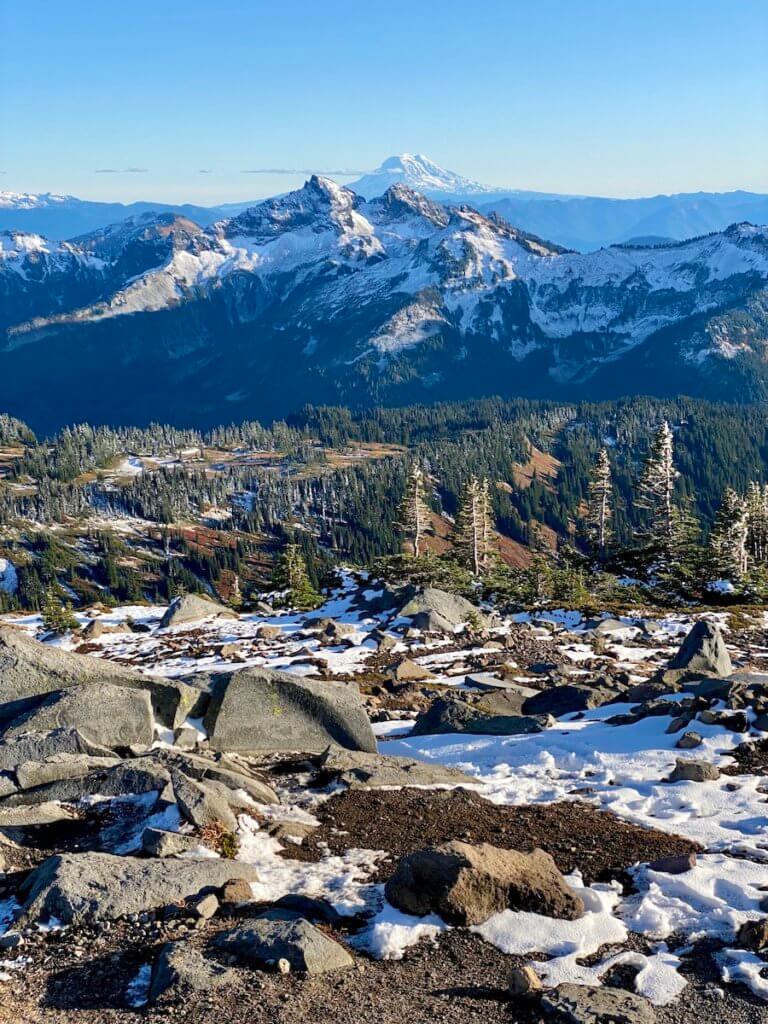
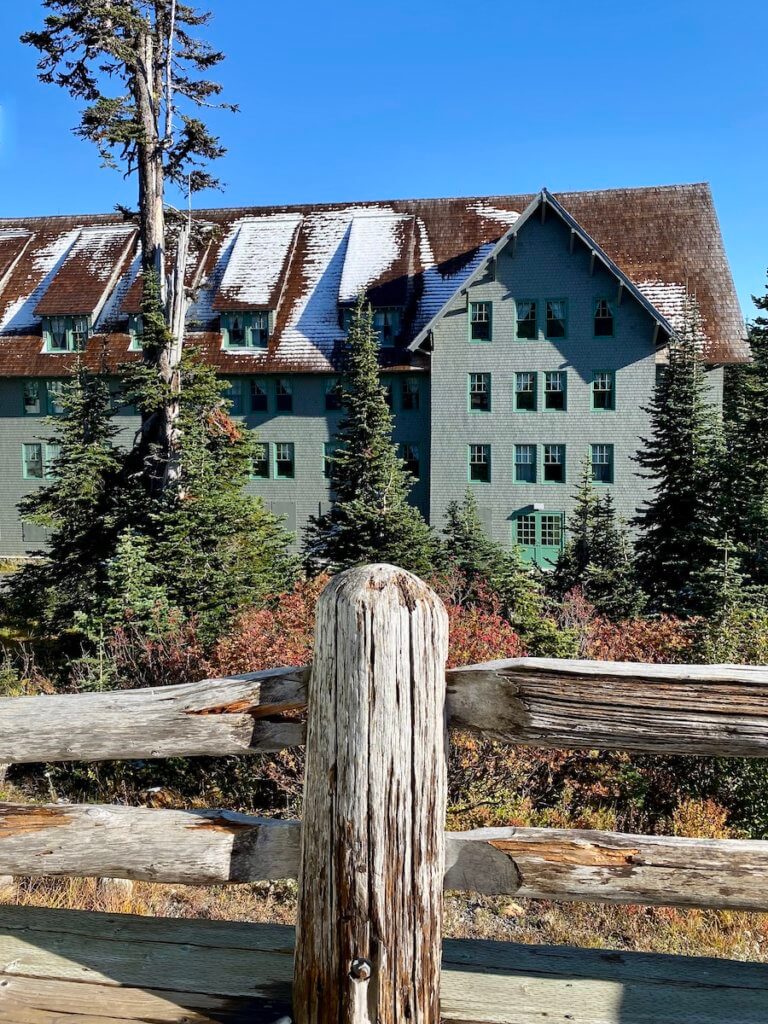
Paradise Inn
Paradise Inn is one of my favorite unique hotels in the Pacific Northwest. Imagine waking up under Pendleton blankets in a rustic room with alpine views out your window. Plan the next hike from the grandiose lodge lobby and enjoy a fine meal in the dining room. The best part is getting a head start on your day before all the crowds flock to the area — usually after 10AM.
Since my visit is just a few days shy of the Paradise Inn closing for the season, I stay at her sister property National Park Inn, in the historic Longmire area, just inside the Park from the Nisqually Entrance.
Open year round, the National Park Inn is a great option for rustic but comfortable lodging inside the Park. They offer a restaurant with tasty lunch and dinner service. At the time of this writing (October 2021) the restaurant is closed on Mondays and to-go only. You can eat your meal on the front porch of the lodge or in a cozy dining/lobby area. There is also an out building with a General Store that sells snacks, among other items.
If you go — planning information for Mt. Rainier National Park
Mt. Rainier National Park Entrance fees
The most typical entrance fees to Mt. Rainier National Park are shown below. I like the America the Beautiful Pass because it is valid for all federally managed lands. This includes the Bureau of Land Management (BLM) and National Forests. If you plan to visit many places in the PNW, this is very useful. For example, the Gifford-Pinchot National Forest, around Mt. St. Helens, would be included with an America the Beautiful Annual Pass.
- Entrance per regular vehicle (noncommercial and less than 15 seats) is $30 for a seven day period.
- Walk-up or single bike entrance fee is $15 for a seven day period.
- Motorcycle for seven days is $25.
- America the Beautiful Annual Pass is $80 for a twelve month period.
- Check the National Parks website for other fee options.
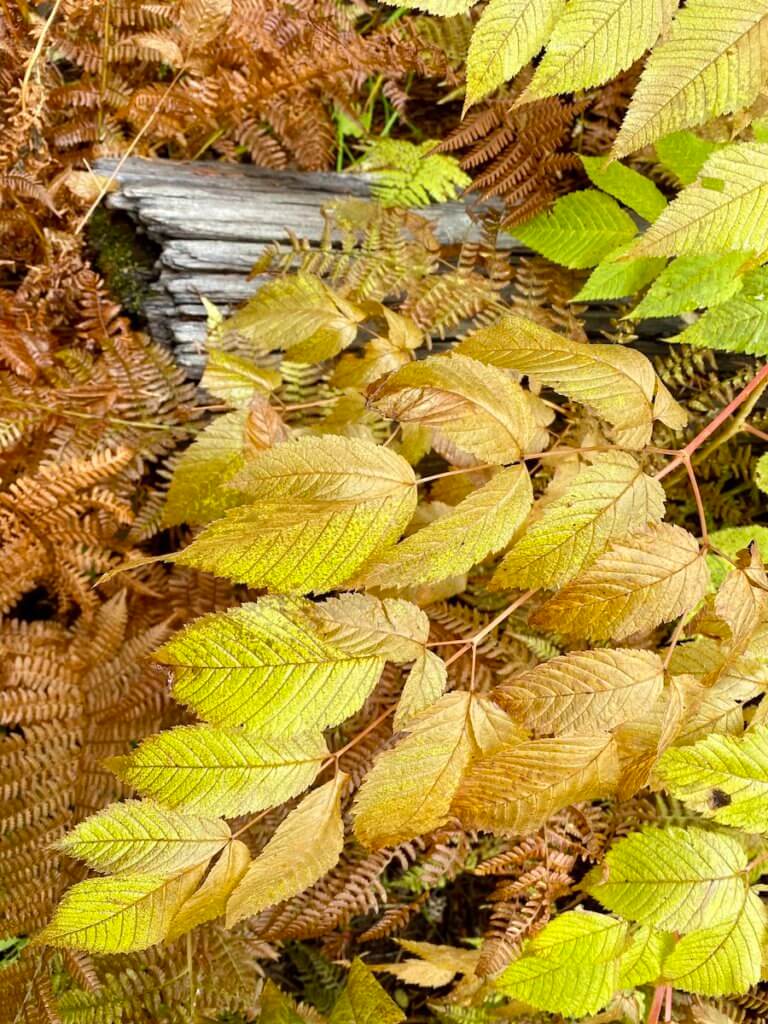

If you go — planning information for Mt. Rainier National Park
Mt. Rainier National Park Entrance fees
The most typical entrance fees to Mt. Rainier National Park are shown below. I like the America the Beautiful Pass because it is valid for all federally managed lands. This includes the Bureau of Land Management (BLM) and National Forests. If you plan to visit many places in the PNW, this is very useful. For example, the Gifford-Pinchot National Forest, around Mt. St. Helens, would be included with an America the Beautiful Annual Pass.
- Entrance per regular vehicle (noncommercial and less than 15 seats) is $30 for a seven day period.
- Walk-up or single bike entrance fee is $15 for a seven day period.
- Motorcycle for seven days is $25.
- America the Beautiful Annual Pass is $80 for a twelve month period.
- Check the National Parks website for other fee options.
Entrances to Mt. Rainier National Park
There are five main approaches to Mt. Rainier National Park and four entrance stations where you can either buy or show existing passes.
- Nisqually Entrance — The busiest because of proximity to Paradise and surrounding areas. Open year round (unless severe weather).
- White River Entrance — Another busy location on the way to stunning Sunrise Day Lodge. The road winds and rises quickly so it’s only open from July to early October. This is the closest entrance to Crystal Mountain Resort.
- Stevens Canyon Entrance — In the area known as Ohanapecosh on the SE corner of the Park. Near the fabulous Grove of the Patriarchs Trail. This road is open seasonally, usually between June and October, weather permitting. This is the closest entrance to Packwood, Washington.
- Carbon River Entrance — Most remote location on the NW corner of the Park. Only open to biking and hiking and gateway to the Carbon River Rainforest Trail.
